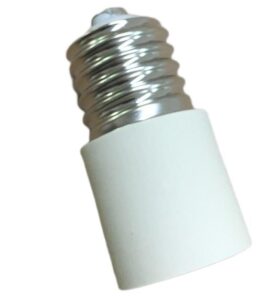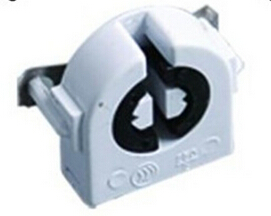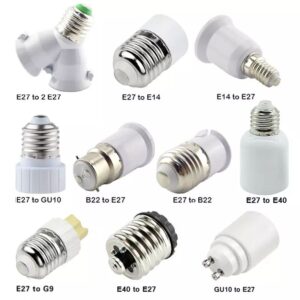Choosing the right lamp socket for your lamp is important for safety, performance, and functionality. There are a lot of different types of sockets, so it can be confusing to know which one to use with your specific bulb and lamp. The wrong socket can cause all sorts of problems like overheating, poor light, or damaging your fixture. Understanding the key factors like bulb type, socket size, wattage, and material will help you make a good decision when choosing a socket.
The type of lamp socket you need depends on the type of bulb (incandescent, CFL, LED), the size of the socket, and the wattage. You can find common sockets like E26, E27, GU10, and G9.
This guide will help you pick the right type of socket for your lamp so you can have a safe lighting system that works great.

Understanding Different Lamp Socket Types
Lamp sockets come in a wide range of configurations to suit different lighting technologies and fixtures. The most common types include:
- Edison Screw Sockets: These are the most recognizable and widely used lamp sockets. They are named after Thomas Edison and use a screw base for bulb installation. The two most common sizes are E26 and E27, with E26 being standard in North America and E27 in Europe. These sockets are used with screw-in bulbs, such as incandescent, CFL, and many LED bulbs.
- Pin-Based Sockets: Often used for halogen and compact fluorescent bulbs, these sockets require bulbs with two or more metal pins that fit into corresponding holes. Popular pin-based sockets include GU10, G4, and G9, each suited for different lighting applications. These sockets are commonly found in spotlights, recessed lighting, and compact light fixtures.
- Specialized Sockets: Some lamps may require specialized sockets, such as R7s for linear halogen bulbs or B22 bayonet sockets commonly used in Europe. These sockets are less common in everyday household lighting but are frequently found in industrial or outdoor fixtures.
Understanding the type of socket your lamp needs depends on the bulb type and the fixture’s design. Each socket has a specific purpose and matching it with the right bulb is crucial for ensuring optimal performance.

Determining the Correct Socket Size for Your Lamp
One of the most important aspects of choosing a lamp socket is selecting the correct size. The size of the socket is typically measured by the diameter of the base that the bulb screws into or plugs into. For example:
- E26 (26mm) and E27 (27mm) are standard socket sizes used for most household lighting in North America and Europe, respectively. These are suitable for common light bulbs like incandescent, LED, and CFLs.
- E12 (12mm) and E14 (14mm) are smaller versions of the Edison screw socket, typically used in chandeliers, decorative lighting, or small lamps. These are often called “candelabra” bases due to their size and shape.
To determine the correct socket size for your lamp, measure the diameter of the existing socket or the base of the bulb. Matching the bulb’s base size to the socket is critical for ensuring a secure fit. Installing a bulb in a socket that is too large or small will not only lead to poor performance but can also be dangerous.
If your lamp already has a bulb, check the base for any markings like “E26” or “E27” that indicate the socket size. You can also consult the lamp’s manual or packaging for further details.
Choosing Based on Bulb Type
The type of bulb you plan to use in your lamp directly influences the type of socket you need. Not all sockets are compatible with every type of bulb, so it’s important to understand the differences between bulb types:
- LED Bulbs: LED technology has become the most popular due to its energy efficiency and long lifespan. Most LED bulbs are designed to fit Edison screw sockets like E26 or E27, making them easy to use in standard household lamps. However, certain LED bulbs, such as spotlights or under-cabinet lighting, may require pin-based sockets like GU10.
- Incandescent Bulbs: Traditional incandescent bulbs are often compatible with standard Edison sockets (E26/E27). These bulbs are less energy-efficient but can be used in older fixtures. However, many are being phased out in favor of more energy-efficient alternatives.
- CFL Bulbs: Compact Fluorescent Lamps (CFLs) are an older energy-efficient alternative to incandescent bulbs. Depending on the type of CFL bulb, it may require an Edison socket or a pin-based socket like G4 or G9.
- Halogen Bulbs: Halogen bulbs are used in more specialized lighting applications, such as spotlights and high-intensity lighting. These bulbs often require pin-based sockets like G9, GU10, or R7s for linear halogen fixtures.
When selecting a socket, it’s essential to match the socket type with the bulb you intend to use. For example, if you’re using a GU10 LED spotlight, you will need a GU10 socket. If you’re unsure, check the bulb packaging or lamp manual to see which socket type is recommended.

Considering Wattage and Voltage Requirements
Each lamp socket is rated for a specific range of wattage and voltage, and exceeding these limits can result in overheating or damage to your lamp or bulb. For safety, it’s crucial to check the maximum wattage and voltage ratings of both the socket and the bulb.
- Wattage: Most standard sockets, like E26/E27, are rated for light bulbs up to 60-100 watts. However, many LED bulbs use significantly less wattage, so you may not need to worry about exceeding the limit. If you’re using incandescent or halogen bulbs, make sure the wattage does not exceed the socket’s rating to avoid overheating or damage.
- Voltage: In most residential settings, the voltage from the socket will be around 110-120V in North America or 220-240V in Europe. Make sure that both the socket and bulb are compatible with the same voltage standard. For example, using a bulb rated for 220V in a 110V socket will cause the bulb to underperform or not light up at all.
Always check the specifications of both the socket and the bulb to ensure they are compatible in terms of wattage and voltage. This step is critical to avoid electrical hazards or premature failure of your lamp and bulb.

Special Considerations: Heat Resistance and Durability
Certain lighting setups, especially those that use halogen or high-wattage bulbs, generate more heat than standard bulbs. In these cases, you’ll need a heat-resistant socket to ensure safe operation. Materials like ceramic and bakelite are excellent choices for high-heat environments because they can withstand higher temperatures without melting or warping.
- Ceramic Sockets: These are highly durable and heat-resistant, making them ideal for use with halogen or high-wattage incandescent bulbs. They are commonly found in kitchen lights, bathroom fixtures, and outdoor lighting where heat buildup can be a concern.
- Bakelite Sockets: Bakelite, a type of heat-resistant plastic, is another material commonly used in lamp sockets. It is less expensive than ceramic but still offers good heat resistance for moderate wattage bulbs, making it suitable for LEDs and CFLs.
When choosing a socket, consider the amount of heat the bulb will generate and select a socket material that can handle it. For high-heat environments, ceramic sockets are often the best choice.

How to Identify the Socket Your Lamp Currently Uses
If you’re unsure of the type of socket your lamp uses, the easiest way to find out is by examining the existing socket. Here are a few steps to help you identify the socket type:
- Remove the bulb: Carefully unscrew or pull out the bulb from the socket. Check the base of the socket for any printed information, such as “E26,” “E27,” “GU10,” or “G9,” which indicates the socket type.
- Measure the socket: If no markings are visible, measure the diameter of the socket using a ruler or caliper. Compare this measurement with common socket sizes (e.g., 26mm for E26, 27mm for E27) to determine the correct size.
- Check the lamp’s manual: If the lamp is new, the manual or packaging will usually list the required socket type. Refer to this information to ensure you use the correct bulb and socket combination.
By identifying the correct socket type, you can confidently purchase compatible bulbs and avoid any issues with improper fit or electrical hazards.

Final Words
Selecting the right lamp socket for your lamp will make sure it works safely and well. The most important things you need to consider are the type of bulb, the size of the socket, the wattage, and the voltage. Whether you’re working with the standard Edison socket, a pin-based socket, or a specialized socket, choosing the right socket is important for the performance and safety of your lamp.
Match the type of socket to your bulb and lamp. When you have the right socket, you’ll have a great, bright light without any problems with overheating, damage, or electrical issues.













